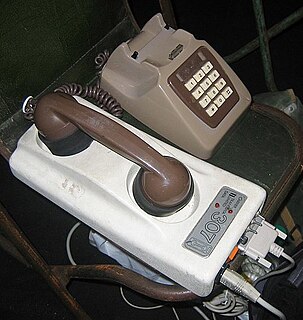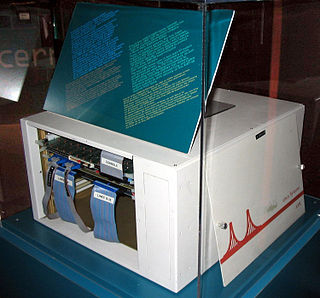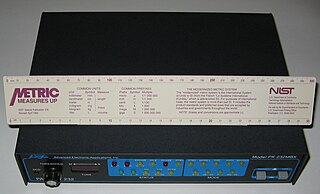ISDN
In ISDN terminology, the terminal adapter connects a terminal (computer) to the ISDN network. The TA therefore fulfills a similar function to the ones a modem has on the POTS network, and is therefore sometimes called an ISDN modem. The latter term, however, is partially misleading as there is no modulation or demodulation performed.

A modem is a hardware device that converts data between transmission media so that it can be transmitted from computer to computer. The goal is to produce a signal that can be transmitted easily and decoded to reproduce the original digital data. Modems can be used with any means of transmitting analog signals from light-emitting diodes to radio. A common type of modem is one that turns the digital data of a computer into modulated electrical signal for transmission over telephone lines and demodulated by another modem at the receiver side to recover the digital data.
Plain old telephone service (POTS), or plain ordinary telephone service, is a retronym for voice-grade telephone service employing analog signal transmission over copper loops. POTS was the standard service offering from telephone companies from 1876 until 1988 in the United States when the Integrated Services Digital Network (ISDN) Basic Rate Interface (BRI) was introduced, followed by cellular telephone systems, and voice over IP (VoIP). POTS remains the basic form of residential and small business service connection to the telephone network in many parts of the world. The term reflects the technology that has been available since the introduction of the public telephone system in the late 19th century, in a form mostly unchanged despite the introduction of Touch-Tone dialing, electronic telephone exchanges and fiber-optic communication into the public switched telephone network (PSTN).
In electronics and telecommunications, modulation is the process of varying one or more properties of a periodic waveform, called the carrier signal, with a modulating signal that typically contains information to be transmitted. Most radio systems in the 20th century used frequency modulation (FM) or amplitude modulation (AM) for radio broadcast.
There are devices on the market that combine the functions of an ISDN TA with those of a classical modem (with an ISDN line interface). These combined TA/modems permit connections from both ISDN and analog-line/modem counterparts. In addition, a TA may contain an interface and codec for one or more analog telephone lines (aka a/b line), allowing an existing POTS installation to be upgraded to ISDN without changing phones.
A codec is a device or computer program for encoding or decoding a digital data stream or signal. Codec is a portmanteau of coder-decoder.
Terminal adapters typically connect to a basic rate interface (S0, sometimes also U0). On the terminal side, the most popular interfaces are RS-232 serial and USB; others like V.35 or RS-449 are only of historical interest.
The S interface or S reference point, also known as S0, is a user–network interface reference point for basic rate access in an Integrated Services Digital Network (ISDN) environment, that
The U interface or U reference point is a Basic Rate Interface (BRI) in the local loop of an Integrated Services Digital Network (ISDN). It is characterized by the use of a 2-wire transmission system that connects the network termination type 1 (NT1) on the customer's premises and the line termination (LT) in the carrier's local exchange. It is not as distance sensitive as a service using an S interface or T interface.
In telecommunications, RS-232, Recommended Standard 232 is a standard introduced in 1960 for serial communication transmission of data. It formally defines the signals connecting between a DTE such as a computer terminal, and a DCE, such as a modem. The RS-232 standard had been commonly used in computer serial ports. The standard defines the electrical characteristics and timing of signals, the meaning of signals, and the physical size and pinout of connectors. The current version of the standard is TIA-232-F Interface Between Data Terminal Equipment and Data Circuit-Terminating Equipment Employing Serial Binary Data Interchange, issued in 1997.
Devices connecting ISDN to a network (e.g. Ethernet) commonly include routing functionality; while they technically include a TA function, they are referred to as (ISDN) routers.

Ethernet is a family of computer networking technologies commonly used in local area networks (LAN), metropolitan area networks (MAN) and wide area networks (WAN). It was commercially introduced in 1980 and first standardized in 1983 as IEEE 802.3, and has since retained a good deal of backward compatibility and been refined to support higher bit rates and longer link distances. Over time, Ethernet has largely replaced competing wired LAN technologies such as Token Ring, FDDI and ARCNET.

A router is a networking device that forwards data packets between computer networks. Routers perform the traffic directing functions on the Internet. Data sent through the internet, such as a web page or email, is in the form of data packets. A packet is typically forwarded from one router to another router through the networks that constitute an internetwork until it reaches its destination node.

Integrated Services Digital Network (ISDN) is a set of communication standards for simultaneous digital transmission of voice, video, data, and other network services over the traditional circuits of the public switched telephone network. It was first defined in 1988 in the CCITT red book. Prior to ISDN, the telephone system was viewed as a way to transport voice, with some special services available for data. The key feature of ISDN is that it integrates speech and data on the same lines, adding features that were not available in the classic telephone system. The ISDN standards define several kinds of access interfaces, such as Basic Rate Interface (BRI), Primary Rate Interface (PRI), Narrowband ISDN (N-ISDN), and Broadband ISDN (B-ISDN).
Loopback, or loop-back, refers to the routing of electronic signals, digital data streams, or flows of items back to their source without intentional processing or modification. This is primarily a means of testing the communications infrastructure.
GeoPort is a serial data system used on some models of the Apple Macintosh that could be externally clocked to run at a 2 Mbit/s data rate. GeoPort slightly modified the existing Mac serial port pins to allow the computer's internal DSP hardware or software to send data that, when passed to a digital-to-analog converter, emulated various devices such as modems and fax machines. GeoPort could be found on late-model 68K-based machines as well as many pre-USB Power Macintosh models. Some later Macintosh models also included an internal GeoPort via an internal connector on the Communications Slot. Apple GeoPort technology is now obsolete, and modem support is typically offered through USB.

A digital subscriber line access multiplexer is a network device, often located in telephone exchanges, that connects multiple customer digital subscriber line (DSL) interfaces to a high-speed digital communications channel using multiplexing techniques.
RS-422, also known as TIA/EIA-422, is a technical standard originated by the Electronic Industries Alliance that specifies electrical characteristics of a digital signaling circuit. Differential signaling can transmit data at rates as high as 10 Mbit/s, or may be sent on cables as long as 1,500 meters. Some systems directly interconnect using RS-422 signals, or RS-422 converters may be used to extend the range of RS-232 connections. The standard only defines signal levels; other properties of a serial interface, such as electrical connectors and pin wiring, are part of the RS-449 and RS-530 standards.

Null modem is a communication method to directly connect two DTEs using an RS-232 serial cable. The name stems from the historical use of RS-232 cables to connect two teleprinter devices or two modems in order to communicate with one another; null modem communication refers to using a crossed-over RS-232 cable to connect the teleprinters directly to one another without the modems.
It is also used to serially connect a computer to a printer, since both are DTE, and is known as a Printer Cable.

A terminal node controller (TNC) is a device used by amateur radio operators to participate in AX.25 packet radio networks. It is similar in function to the Packet Assembler/Disassemblers used on X.25 networks, with the addition of a modem to convert baseband digital signals to audio tones.

Gandalf Technologies, or simply Gandalf, was a Canadian data communications company based in Ottawa. It was best known for their modems and terminal adaptors that allowed computer terminals to connect to a number of host computers through a single interface.
RS-485, also known as TIA-485(-A), EIA-485, is a standard defining the electrical characteristics of drivers and receivers for use in serial communications systems. Electrical signaling is balanced, and multipoint systems are supported. The standard is jointly published by the Telecommunications Industry Association and Electronic Industries Alliance (TIA/EIA). Digital communications networks implementing the standard can be used effectively over long distances and in electrically noisy environments. Multiple receivers may be connected to such a network in a linear, multidrop bus. These characteristics make RS-485 useful in industrial control systems and similar applications.
A mobile station (MS) comprises all user equipment and software needed for communication with a mobile network.
USB communications device class is a composite Universal Serial Bus device class. The class may include more than one interface, such as a custom control interface, data interface, audio, or mass storage related interfaces.
A network termination (NT) is a device that connects the customer's data or telephone equipment to a carrier's line that comes into a building or an office. The NT device provides a connection for terminal equipment (TE) and terminal adapter (TA) equipment to the local loop.
Networking hardware, also known as network equipment or computer networking devices, are physical devices which are required for communication and interaction between devices on a computer network. Specifically, they mediate data in a computer network. Units which are the last receiver or generate data are called hosts or data terminal equipment.
A terminal server enables organizations to connect devices with an RS-232, RS-422 or RS-485 serial interface to a local area network (LAN). Products marketed as terminal servers can be very simple devices that do not offer any security functionality, such as data encryption and user authentication. The primary application scenario is to enable serial devices to access network server applications, or vice versa, where security of the data on the LAN is not generally an issue. There are also many terminal servers on the market that have highly advanced security functionality to ensure that only qualified personnel can access various servers and that any data that is transmitted across the LAN, or over the Internet, is encrypted. Usually companies which need a terminal server with these advanced functions want to remotely control, monitor, diagnose and troubleshoot equipment over a telecommunications network.

The PS/2 port is a 6-pin mini-DIN connector used for connecting keyboards and mice to a PC compatible computer system. Its name comes from the IBM Personal System/2 series of personal computers, with which it was introduced in 1987. The PS/2 mouse connector generally replaced the older DE-9 RS-232 "serial mouse" connector, while the PS/2 keyboard connector replaced the larger 5-pin/180° DIN connector used in the IBM PC/AT design. The PS/2 keyboard port is electrically and logically identical to the IBM AT keyboard port, differing only in the type of electrical connector used. The PS/2 platform introduced a second port with the same design as the keyboard port for use to connect a mouse; thus the PS/2-style keyboard and mouse interfaces are electrically similar and employ the same communication protocol. However, unlike the otherwise similar Apple Desktop Bus connector used by Apple, a given system's keyboard and mouse port may not be interchangeable since the two devices use different sets of commands and the device drivers generally are hard-coded to communicate with each device at the address of the port that is conventionally assigned to that device.
Reverse telnet is a specialized application of telnet, where the server side of the connection reads and writes data to a computer terminal line, rather than providing a command shell to the host device. Typically, reverse telnet is implemented on an embedded device, which has an Ethernet network interface and serial port(s). Through the use of reverse telnet on such a device, IP-networked users can use telnet to access serially-connected devices.

Fritz!Box, stylised as FRITZ!Box, is a series of residential gateway devices produced by the German company AVM GmbH. In 2010 it was estimated the series had a market share of 68% of the digital subscriber line (DSL) consumer equipment in Germany.
COM One group was a manufacturer best known for its computer network adapters. The company was co-founded in 1987 by Jacques Saubade and Michel Petit and was headquartered in France. The name comes from the company's focus on modems.
Data Terminal Ready (DTR) is a control signal in RS-232 serial communications, transmitted from data terminal equipment (DTE), such as a computer, to data communications equipment (DCE), for example a modem, to indicate that the terminal is ready for communications and the modem may initiate a communications channel.










